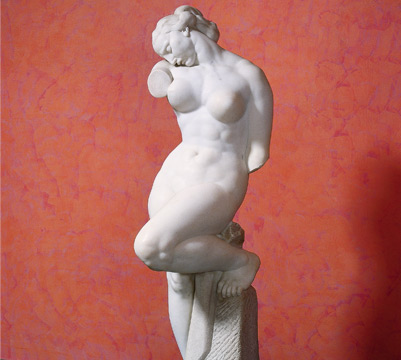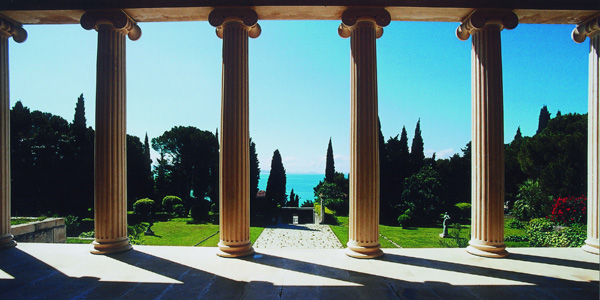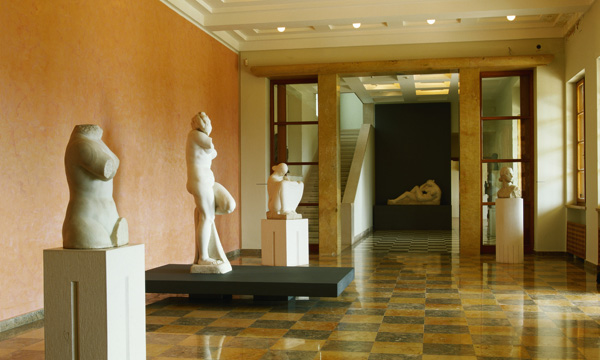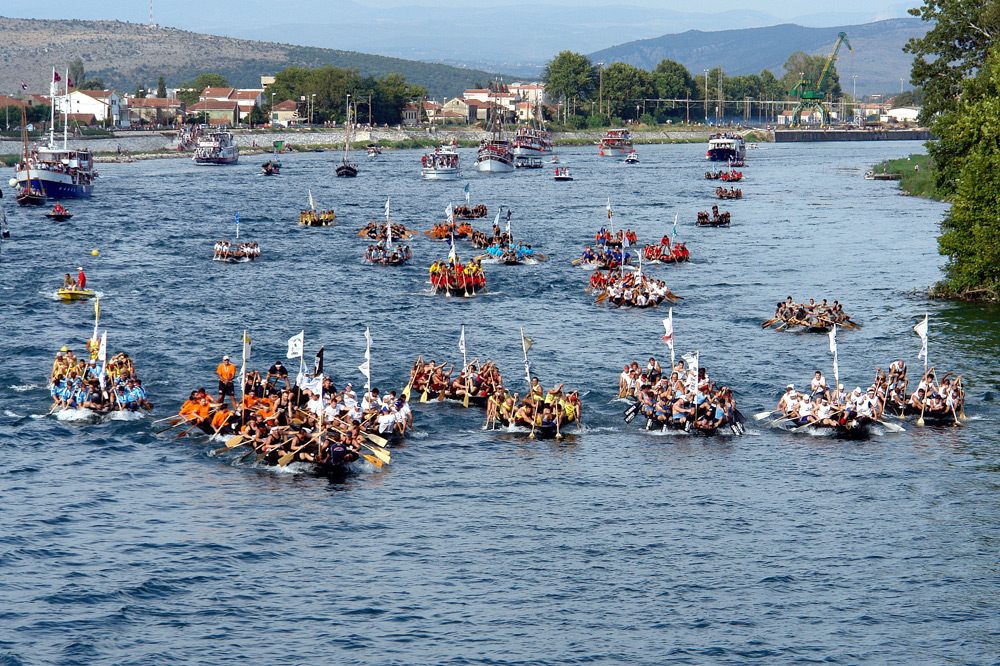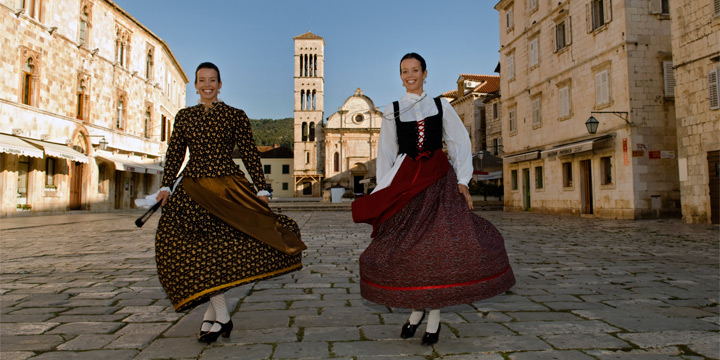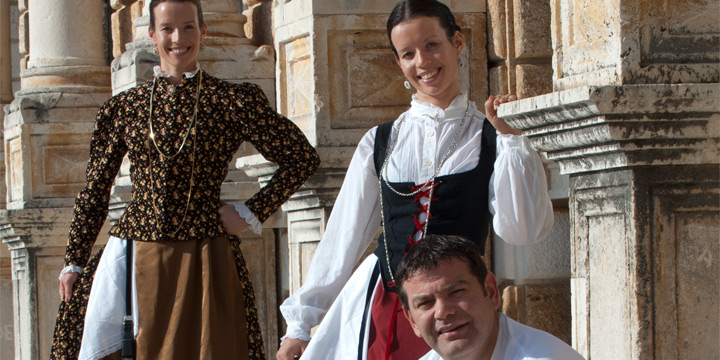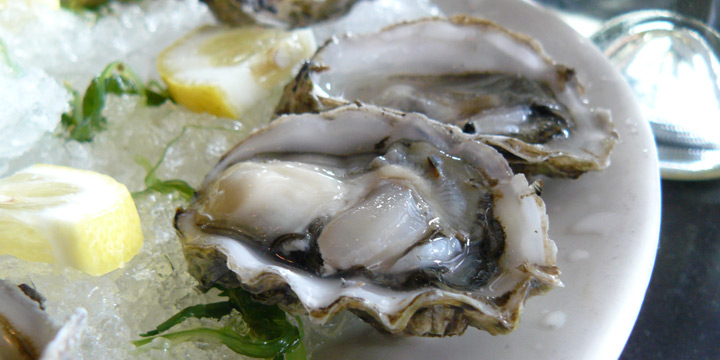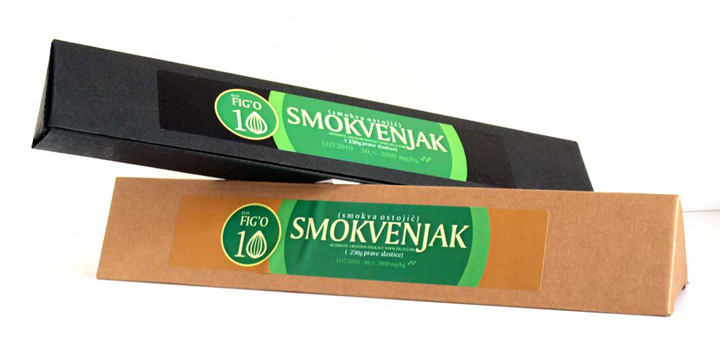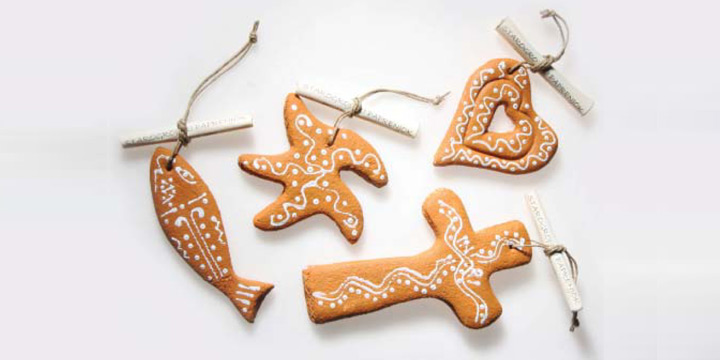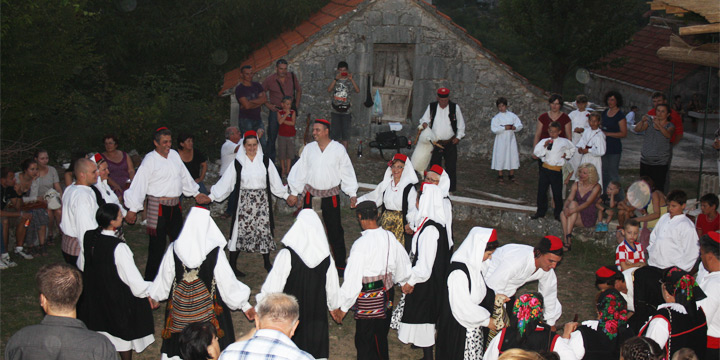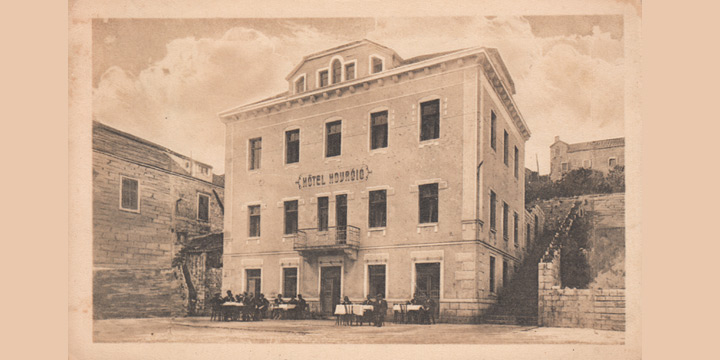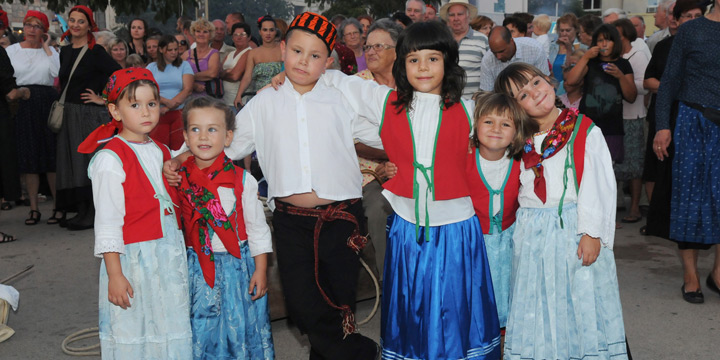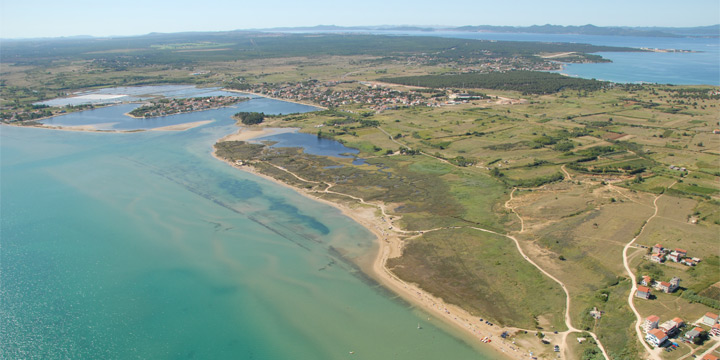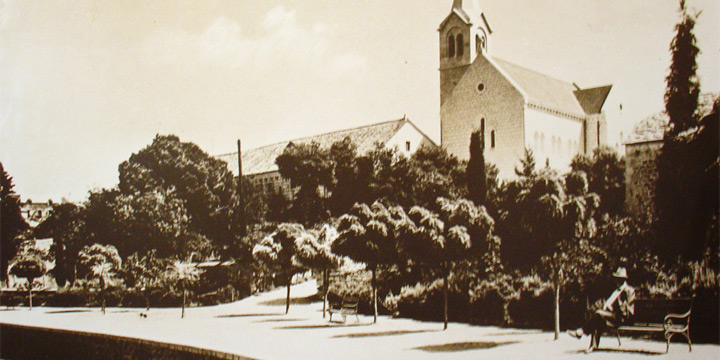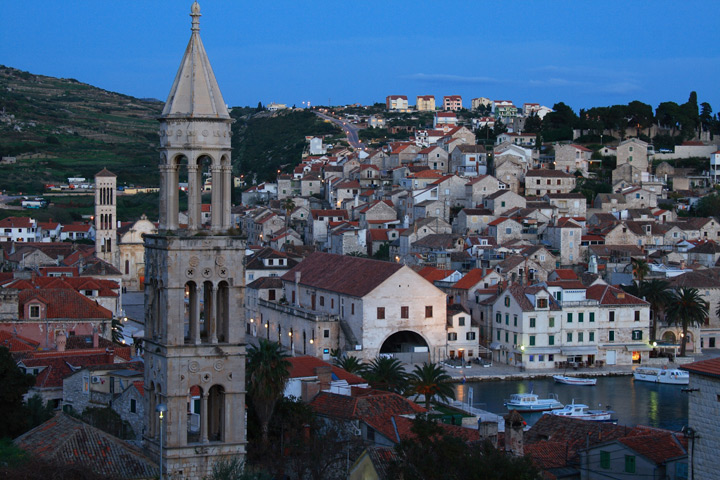Ivan Meštrović - artist admired all over the world
A country of only 4 million people, keeps a collection of works of world's most famous sculptor. Your arrival to Split should definitely include a visit to Meštrović Gallery, and Meštrović’s Crikvine – Kaštilac.
The all-time artist, as many describe Ivan Meštrović, was born in 1883 in Vrpolje. He spent his childhood in Otavice, Dalmatian hinterland village which is now proud of his family tomb.
His apprenticeship began in Split in the stonemason's workshop of Harold Bilinić, followed by a five-year study at the Vienna Academy of Fine Arts. He was a versatile artist: sculptor, author of several architectural and literary works, participant in important political events. By exhibiting with the Vienna Secession artistic group in the period from 1903 to 1910, the young Meštrović gained full recognition, and most of his early works are of symbolic nature - Fountain of Life in Zagreb (1905).
However, it was always said that one cannot be formed as an artist, if he or she is not living and working in Paris. Meštrović settles in the French capital in 1908 where he rents an atelier in Montparnasse. There he creates his epic works, as myth and symbol were not only part of national, but also of European, especially Secessional spiritual climate. Such works were exhibited in 1910 in Vienna and Zagreb, and have caused considerable interest in the world exhibition in Rome, where he received the first prize in the category of sculpture. In the same event Gustav Klimt was awarded, for painting.
Construction of the tomb chapel of the Račić family in Cavtat (1920 - 1923) is just the beginning of his fruitful work - he moves to Zagreb, where he adapts a house (1921 - 1924) and builds a studio. Today it is the Meštrović Atelier, a memorial setting with a permanent exhibition of the artist's works.
The works from the third decade are marked by his expressive classical design, particularly of female acts. With full intensity he works on the public monuments as well, including those outside Croatia. So the city of Chicago commissioned Meštrović to produce a monument to the Indians - two equestrian sculptures set in the Central Grant Park in 1928 are still there.
In 1938 he realizes yet another construction project: The Chamber of Fine Arts in Zagreb. This circular building is an inevitable piece of Croatian modern architecture on which Meštrović was first to apply the circular flow of the tour of the exhibits. He connected the ground and the first floor with a ramp, and lit the space by a natural light. The idea of such character of space was used twenty years later in much larger dimensions, by the famous architect Frank Lloyd Wright who built Gugennheim Museum in New York.
In the United States he dedicated himself to pedagogical work at the University of Syracuse, New York; and then at the University of Notre Dame in South Bend, Indiana. In 1954 he became an American citizen, and since 1960 a member of the American Academy of Arts and Literature. In the United States he completes a cycle of wooden reliefs, which he started almost forty years ago, on the subject of Jesus from Nazareth. He gives away this particular unit, which is considered a masterpiece of sacred art of the 20th century, for a display in the chapel of St. Cross on Crikvine - Kaštilac in Split.
It has to be singled out that Ivan Meštrović donated to the Croatian people the majority of his works - among other things, the Church of The Holy Redeemer in Otavice where he was buried, according to his own wishes. On the basis of a Contract of donation, the Ivan Meštrović foundation was established in Zagreb in 1991, and the Croatian Parliament adopts the Law on Ivan Meštrović Museums in 2007.
Photo: Muzeji Ivana Meštrovića
Neretva
[nivo effect="fade" slices="3" directionNav="button" controlNav="true" width="720px" height="360px"]
[image caption="Maraton na Neretvi"]http://hotspots.net.hr/wp-content/uploads/2012/03/Maraton-na-neretvi-pod-Metkovicem.jpg[/image]
[image caption="Neretva"]http://hotspots.net.hr/wp-content/uploads/2012/03/neretva_1.jpg[/image]
[image caption="Panorama Metkovića"]http://hotspots.net.hr/wp-content/uploads/2012/03/metkovic-panorama-za-autobus.jpg[/image]
[image caption="Neretva"]http://hotspots.net.hr/wp-content/uploads/2012/03/neretva_2.jpg[/image]
[image caption="Ribarenje na Neretvi"]http://hotspots.net.hr/wp-content/uploads/2012/04/pct_180507v1.jpg[/image]
[image caption="Vid, rijeka Norin"]http://hotspots.net.hr/wp-content/uploads/2012/04/Vid-Norin.jpg[/image]
[image caption="Rijeka Norin po noći"]http://hotspots.net.hr/wp-content/uploads/2012/04/River-Norin-by-night1.jpg[/image]
[image caption="Panorama Predolac"]http://hotspots.net.hr/wp-content/uploads/2012/04/panorama-predolac.jpg[/image]
[image caption="Most"]http://hotspots.net.hr/wp-content/uploads/2012/04/MOST.jpg[/image]
[image caption="Neretva"]http://hotspots.net.hr/wp-content/uploads/2012/04/P5067709.jpg[/image]
[/nivo]
The last delta of Europe - richness at the Neretva estuary
In addition to the beautiful islands, mountains, karst and fertile hinterland, Dalmatia is proud of the latest Delta of Europe - Neretva river mouth.
The delta of the Neretva River, from Metković to the estuary on the north and northeast, is bordered by branches of the Dinaric Alps, and to the south by hills. To the west it is open to the sea and is under its constant influence. Precisely this brackish water is the right place for the growth of vegetation and fish fund. The wildlife is also diversified here - the last species of birds, which couldn’t be seen anywhere else in Europe, made their nests in this marsh area.
Climatic influences are very suitable for agriculture, for the famous Neretva tangerines and other citrus fruits, among which in the past years clementines have become increasingly popular, whereas at the beginning of the summer, it is all about peaches and nectarines. Precisely picking these cultures for years also represents a type of tourism that Neretvians have arranged for their guests. We must not forget hunting and fishing, which also brought many at the Neretva river delta… and after hunting and eels fishing, you can try preparing these delicacies, typical for this region.
In addition to these activities, even if you are not the athletic type, you will surely enjoy the photo safari through the backwaters of the river. A ride in the Neretva boat (you can paddle on your own, or choose a motor drive) through the vast backwaters, tributaries and lakes, finalized with occasional lunch at one of the many ranches (with an outdoor barbecue and homemade bread), will make one of the best memories. The Neretva River delta is a natural phenomenon, and a must-see!
Photo and text: TZ Metkovića
Two sisters below the olympic rings – Ana and Lucija Zaninović, rulers of the world's tatamis
[nivo effect="fade" directionNav="button" controlNav="true" width="720px" height="360px"]
[image caption="Ana and Lucija Zaninović, rulers of the world's tatamis"]http://hotspots.net.hr/wp-content/uploads/2012/05/Zaninovic_3.jpg[/image]
[image caption="Ana and Lucija Zaninović, rulers of the world's tatamis"]http://hotspots.net.hr/wp-content/uploads/2012/05/Zaninovic_4.jpg[/image]
[image caption="Ana and Lucija Zaninović, rulers of the world's tatamis"]http://hotspots.net.hr/wp-content/uploads/2012/05/Zaninovic_2.jpg[/image]
[image caption="Ana and Lucija Zaninović, rulers of the world's tatamis"]http://hotspots.net.hr/wp-content/uploads/2012/05/Zaninovic_1.jpg[/image]
[/nivo]
Remarkable sportswomen for a top destination
The two sisters, Hvarian by birth, world and European champions in tae kwon-do, will perform at the Olympic Games in London 2012. Except sports, they will also defend brand of Hvar as a hot spots destination.
By monitoring global tourism trends, editorial department of the Croatian tourist magazine "Dalmatian hot spots" decided to choose Hvar for a 2011 hot spots destination and for a cover of the winter edition.
Top athletes, world and European champions in tae kwon do, sisters Ana and Lucija Zaninović, along with numerous trips and obligations were able to dedicate one day to our magazine, to be photographed for the cover.
- Year of sports success is behind you, medals were won - have you achieved your goals?
Ana and: Yes, we are satisfied ... very pleased. This is for us a year of great success, a dream come true.
Lucija: Since we started playing we dreamed that we will qualify for the Olympics. And these Olympics at which we both participate is the crown of many years of work.
- Now you have suddenly found yourselves in the role of promoter of sports life, but your personal life generated media attention as well - how do you deal with that? Is it hard to be a role model for young people?
Lucija: So far we encountered only sympathies – both from the media and fans. We want to show young people, through our own example, how perseverance and positive thinking can attain great results.
- You are also promoters of our country, and now also of tourism on Hvar, since you come from Velo Grablje?
Ana: We speak of our country only in superlatives ... We traveled all over the world and nothing can compare to the beauty of our coast.
- You often travel around the world - are there any queries about the beauty of Hvar and the Croatian coast?
Lucija: In foreign countries, especially in the East, people have heard for Croatia over athletes and sports successes. In gatherings after the event we often show pictures of our coast. Split is a candidate of the organization of World Championships in Tae-kwon-do for 2013. We have already heard stories that we are favorites, along with Mexico, Turkey and Azerbaijan, which would be a great success, because Croatia has never hosted such a big competition.
- In addition to sports obligations you are both studying - you are students of Aspira how do you fulfill all tasks, those of sports and those of students?
Lucija: We execute our athlete obligations as best we can, through continuous and recurrent training and participation in all major competitions. Aswell as those of a student... Specifically, Aspira – The College of Sports Management has a lot of understanding for top athletes. With good organization everything can be done.
- One cannot live on sports, except when it comes to football. Acquiring knowledge is essential - where do you see yourself after removing the kimonos?
Ana: Tae kwon-do is a poorly paid sport. But even after the end of our career and with a degree in hand, we can see ourselves in club activities, or in some state sports structures.
- But now all your thoughts are directed to London 2012 and the Olympic Games. You are expecting a lot - how are the preparations going?
Lucija: As the event approaches, nervousness will be growing: therefore we plan to prepare ourselves abroad, in order to be exempt from public pressure and 100% focused on training and achieving results. Our only wish is to preserve health, to annul injuries. So everything is possible in London.
- Are you going to attend any other competition prior to Olympic Games?
Ana: We intend to participate in a stronger tournaments in Europe, first in Belgium and then in Germany, as well as in the Student Championships in Korea. However, everything still depends on our health and physical readiness!
Hvar major Pjerino Bebić, this year's laureate for the best potestatem
[nivo effect="fade" directionNav="button" controlNav="true" width="720px" height="360px"]
[image caption="Interview: Hvar major Pjerino Bebić"]http://hotspots.net.hr/wp-content/uploads/2012/05/Pjerino-Bebic.jpg[/image]
[image caption="Interview: Hvar major Pjerino Bebić"]http://hotspots.net.hr/wp-content/uploads/2012/05/Pjerino-Bebic1.jpg[/image]
[image caption="Interview: Hvar major Pjerino Bebić"]http://hotspots.net.hr/wp-content/uploads/2012/05/Pjerino-Bebic2.jpg[/image]
[/nivo]
Together to the top of the world!
A lot of the collective effort of all Hvar people and their longtime hard work brought results, so the city is the number one tourist destination. However, while in some respects they are at the very top, in some others they are like the last hole on the flute, when it comes to the attitude of Jadrolinija towards these islanders, who are, without good transport links – dying…
For a long time has the name of Hvar been a synonymous of top quality tourism, of holiday on the sunniest island, in a city which boasts the oldest theater in Europe, beautiful beaches, Pakleni Islands - a paradise for boaters, and since recently they also have the best potestatem.
Reason enough for a discussion with the first man of Hvar, Pjerino Bebić.
-Are you flattered by the title of the best mayor, the prize that was assigned to you on the past Days of Tourism held in Šibenik?
It is very flattering because it is awarded from relevant institutions and jury. But I see it as a collective award to the whole city. In pretty rough time of transformations in Croatia, it knew how to direct positive energy and work in its own interest and for the benefit of local families, which is in our city strongly intertwined. People raised loans, believed in improving the quality of service, sincerely supported infrastructure projects that enabled us to make a real quantum leap for Hvar. To me, it would be a highest recognition when anyone in Hvar would be aware of their contribution to every award which is given to our city. Similarly, on the whole island there are fantastic examples of a payoff of many years of work and effort. All this, organized in a complex story, helped our city and the island to become a top destination, without which no travel chart can pass.
- How much effort does it takes to receive the award by the profession?
A lot of collective and long-term effort! In these projects, one is like none. I hope that I will never fail to congratulate, again and again, to everyone in the town of Hvar who cares about common good and the quality life of the community. Remember that we, in fact, do not have tourists, rather friends who were won over by Hvar and who cannot stop talking to their friends of a great time they had here.
- Since you became potestatem of the city on the sunniest island, were the tourist offer and the structure of services – changed?
In terms of infrastructure, the answer is no. We are still city of several thousands of people, which must have the infrastructure for the 25 000. But in terms of logistics, management and media promotion, I can say that it has changed completely. Sometimes I have a feeling that people “rediscover” Hvar, and that they appreciate it even more.
- According to your opinion, what is the future of tourism on Hvar: elite, nautical, congress, medical, sports?
It is based on the diversity of all these forms. I like to call it Hvarian tourism. Namely, we are developing the concept of how to subsidize rapid transport from the airport (which is under construction) to Hvar to attract congresses, because without them there is no enlargement of the season. Together with the Port Authority of Split County we not only improve the harbor for yachtsmen, but also for local boat owners. From a sports complex, we never gave up ... indeed. And when we talk about elite tourism, I am very happy that our city is visited by royal families and the global jet-set, but Hvar is very accessible to everyone in its own way. The offer is really good and now it can only go better.
- What is necessary for retaining the number one position, and that the name of Hvar still carries a HOT SPOT prefix as the most popular tourist destination?
An airport and subsidized lines. We need an Islander at the top of Jadrolinija. Unfortunately, I have to conclude that there is the incredible lack of understanding of island life by the Jadrolinija administration. Interestingly, on the other hand, our friend who works at ferry line is the winner of this year’s City award, because people do try. But the administration is truly amazing. How does one explain that you can buy a parking ticket over the mobile phone in every bigger city, but there’s no chance to buy a ticket on a route Split-Hvar on a heavily visited weekend, let alone in the peak of a season. So, from some aspects, we are the very top, and from some others, the last hole on the flute!
- You had lots of problems with the Sunčani Hvar (Sunny Hvar) project. What is the situation now?
We worked hard with the government to protect workers' interests and assets of the company. Unfortunately, the number of workers there is such that no more can the enterprise be called the carrier of the city economy. The Sunny Hvar is an enterprise lowered to the level wanted by a private investor in terms of capacity and number of employees. We shouted and shouted, under great pressure, but without any real formal power. Government supported such a vision and financed all together. This issue is obviously absorbed in this manner, because what was allowed was allowed, except if the government miraculously restarts certain issues. The town of Hvar will continue to seek partners for joint projects and I know that we will find them. The situation with Sunny Hvar has shown us that somebody quite rudely snatched one part of the past. There are no more protagonists of this story – some of them are at court, some are hiding, some in prison, but we must go on along with the enterprise.
- Lack of seasonal staff – how do you solve this problem?
We never had an excessive problem with that and vice versa, no one ever had a problem with finding the job in Hvar during the season, but we need more permanent jobs. Nobody plans to establish a family based on a seasonal work, and we need an island that is alive, which we are, and which we want to be forever. We need more islanders!
- What does city offer - wild parties for the young, quiet holidays for families with children or a peaceful vacation for retirees?
The town of Hvar is a place of enjoyment and the rare are those who do not enjoy it. There's nothing that cannot be found here. Hvar offers everything and we always make sure that we not withhold anyone in any way.
- Further branding of Hvar - the present course?
The huge tradition of hospitality and tourism has made of Hvar an ideal choice. Among the targeted groups, the truth is there are many young people who recognize the city and the island of Hvar, and his double life: relaxed at the daytime, exciting at the night. There is a very important group of lovers of hidden coves on the island and on the Pakleni islands, which enjoy an exclusive Robinson tourism. All of this is also recognized by celebrities and business elites, as well as their families.
- The scale is raised high - do you have the willingness and the strength, but also the support of citizens and of the state, to realize your goals?
Hvar is still a mundane destination. We have never dealt with politics, rather with our city: we changed the bulbs in public lighting, dug the sewers, but also welcomed to our dock marine vehicles of the global elite. For a tenacious and sometimes stubborn work on the future of our town, we have always found friends at every level of political power, and I think that will always be correct. In fact, we love to thank these people.
Gastronomy
[nivo effect="fade" directionNav="button" controlNav="true" width="720px" height="360px"]
[image caption="Kamenice"]http://hotspots.net.hr/wp-content/uploads/2012/04/Gastro4-kamenica.jpg[/image]
[image caption="Rožata"]http://hotspots.net.hr/wp-content/uploads/2012/04/Gastro3.jpg[/image]
[/nivo]
Closely related to Split-Dalmatian County's geographical wealth is its gastronomy. In just a short distance, opposites come together - pervading the traditional tastes of days gone by and the creative cuisine of the present day: flavours of untouched nature with just a pinch of salt brought over the hills with the sirocco or the smell of the fireplace and its fragrances brought with the bora over the same hill.
Source: [styled_link link="http://www.dalmatia.hr" variation="slategrey"]www.dalmatia.hr[/styled_link]
Smokvenjak
[nivo effect="fade" directionNav="button" controlNav="true" width="620px" height="360px"]
[image caption="Ostojić, Smokvenjak"]http://hotspots.net.hr/wp-content/uploads/2012/04/Ostojic-smokvenjak.jpg[/image]
[/nivo]
Smokvenjak – traditional dalmatian fig cake is a real nutritional bomb prepared according to the traditional recipe from dried figs. It is enrich with fruit and picant flavours. Perfectly balanced fig mix enriched with ground paper or citrus, is a real gourmet bites. It is served to you with an aperitif in most taverns and restaurants.
INFO:
Tel: +385 (0)98 196 34 78
[styled_link link="http://www.smokva-ostojic.com" variation="slategrey"]www.smokva-ostojic.com[/styled_link]
Pepper cake
[nivo directionNav="button" controlNav="true" width="720px" height="360px"]
[image caption="Starogrojski paprenjak"]http://hotspots.net.hr/wp-content/uploads/2012/04/Starogrojski-paprenjak.jpg[/image]
[/nivo]
Starogrojski paprenjok – pepper - cake souvenir
Starogrojski paprenjok is an original souvenir made as a homage to a traditional biscuit which the women and girls of Stari Grad on the Island of Hvar lovingly prepared since 1167 for their sons and husbands, packing them in sailor's chests before their loved ones' departure on long and faraway journeys. These cakes are prepared according to a carefully preserved recipe of the old island women and retained the traditional shapes of amphora, fish, heart, clover and other imaginative forms lined with sweet stripes and playful dots.
Anel - tbt d.o.o.
Vrisna bb
Jelsa, otok Hvar
[styled_link link="http://www.paprenjok.com" variation="slategrey"]www.paprenjok.com[/styled_link]
People and tradition
[nivo effect="fade" directionNav="button" controlNav="true" width="720px" height="360px"]
[image caption="Ljudi i običaji"]http://www.test-mid.com/dalmatian-hotspots/wp-content/uploads/2012/05/Ljudi-i-obicaji2.jpg[/image]
[image caption="Ljudi i običaji"]http://www.test-mid.com/dalmatian-hotspots/wp-content/uploads/2012/05/Ljudi-i-obicaji.jpg[/image]
[/nivo]
Born surrounded by poor soil, rocks and sea, the Dalmatian people were determined to be sailors, fishermen and farmers. Cultivating crops as the grape vine, figs and tenacious olive trees, nourishing their numerous families on the poor soil, the land worker’s life was arduous and the fisherman’s even more so.
The male members of the family, as fishermen and sailors sailed out into the open sea in order to nourish themselves and their families. While awaiting them, the diligent hands of the women for years were "holding up the four corners of the house" (taking care of everything). The islanders did stone- masonry, bred small herds of cattle and built ships, and in Zagora the land workers cultivated the fertile soil near to the lakes and rivers, and bred cattle and especially pigs.
The Dalmatian is a man of strong emotions who is hard-working and proud, faithful to his friends, traditional songs and a good drink.
Izvor: Tz Splitsko dalmatinske županije
Hvar on a postcard
[nivo effect="fade" directionNav="button" controlNav="true" width="720px" height="360px"]
[image caption="Hvarska kartolina"]http://hotspots.net.hr/wp-content/uploads/2012/04/Hvarska-kartolina.jpg[/image]
[/nivo]
History of Hvar's tourism through old postcards
The results of climate research in mid-nineteenth century have shown excellent properties of Hvar’s climate, suitable for the treatment of various ailments, especially respiratory diseases. Thanks to Franz Unger, botanist from Graz, shortly the idea was born, to take advantage of these benefits and establish health and hygiene facility in Hvar. Hvar Hygienic Society (Societa igienica di Lesina) was founded in 1868, which marks the beginning of the era of modern tourism.
The first hotel was built in a rented house on the south side of the town square and had 13 single rooms with heating and a restaurant. However, the task of Hygienic Society was the construction of a modern health resort. As the Company did not have enough money for its construction, it turned to the court of Vienna for financial support, and expressed the wish that the Queen Elizabeth was the patron and that the hotel carried her name. Construction began in 1881 at the site of the former Duke's Palace, but due to perpetual shortage of funds works have dragged on unexpectedly. The first part of the hotel was completed in 1898 and officially opened on 1 of April 1899. That same year appears the first postcard of Hvar decorated with painted palm trees and agaves, evoking the Mediterranean atmosphere and the mildness of the climate. The top of the postcard was dominated by landscapes of Hvar seen from Paklinski islands, and by Loggia and the Duke’s Palace on the left.
In addition to flyers and advertisements in Austrian journals, Hvar's hoteliers have quickly learned the ability to promote tourism on Hvar via postcards. Frequent motifs were: the Franciscan Monastery, the Cathedral of St. Stephen, the Paladini palace, the Arsenal, the Fortress, church of St. Mark, the Loggia, idyllic sunsets and newly opened hotels.
One of these postcards shows a part of the hotel of Empress Elizabeth, which was, according to the people who pose in front of the hotel and on the windows, already filled with guests. Construction was completed in 1903 and the hotel had 26 rooms with 35 beds, bathroom, dining room and a café (Cur-salon) in the old city Loggia. In Cur-salon one could browse local and foreign newspapers, play cards or billiard, or enjoy concerts, dances and lectures.
At the beginning of 20th century Hygienic Society and the hotel were successfully doing business. Guests were mostly coming from the territory of Austria, Czech Republic and Hungary but also from other countries, with the intention of replacing their cold winters with Hvar’s mild ones. An interesting postcard text (Picture 5), sent to Burlington (Vermont, USA) on 9th September 1905, describes Hvar as "an unique old city that is becoming popular as a winter resort."
The success of the Hygienic Society raised tourism initiatives on the island. In 1911 in Jelsa, a modern hotel “Jadran” was opened, with 14 rooms, dining room, pub, lounge for reading and the nearby seaside resort. The owner of the hotel, captain Miće Žufić was also the publisher of promotional postcards on which the future clients could see the look of the hotel as well as its offer. Shortly afterwards new hotel facility was opened – hotel “Kovačić”, with 30 beds.
Advancement of technology has enabled Hvar to become what the founders of Hygienic Society could only dream of: a world famous tourist destination with increased the number of visitors each year. In the age of the Internet, pictures of Hvar in a few seconds cross from one side of the globe to another. Only the passionate collectors care for old postcards, trying to escape the hectic everyday life, in search of some romantic, ancient times.
Text: Siniša Matković Mikulčić
Photo: Arhiv Tz grada Hvara
Pirate battle
[nivo effect="fade" directionNav="button" controlNav="true" width="720px" height="360px"]
[image caption="Omiš, gusarska bitka"]http://hotspots.net.hr/wp-content/uploads/2012/04/Omis_gusari_1.jpg[/image]
[image caption="Omiš, gusarska bitka"]http://hotspots.net.hr/wp-content/uploads/2012/04/Omis_gusari_3.jpg[/image]
[image caption="Omiš, gusarska bitka"]http://hotspots.net.hr/wp-content/uploads/2012/04/Omis_gusari_2.jpg[/image]
[/nivo]
"Pirate battle Omis 2011"
"Battle-Omis Pirates" has become a traditional summer event for the town of Omis, Split-Dalmatia and Croatian, and it is organized on 18.08. 2011th for the fifth year in the port of Omis.
This event is unique because it reconstructs the original Pirate battle that occurred in the 13th century and thus builds the brand as a city of Omis pirates, all based on historical facts and the development of cultural tourism.
In the reconstruction of original battle directly involved are: members of the “Kumpanija "from Korcula, “Dubrovnik Trombonjeri”, Omiš Pirates, and as a special guest there are “Klis Uskoci”.
Patrons of the event are: the City of Omis, Split-Dalmatia County and the Croatian National Tourist Board. The organizer of the Tourist board of Omis.
It should be noted that in the battle involved about 100 participants under arms, and we expect as last year, more than 10 000 visitors, and coverage by all media.
Joško Stella, idejni tvorac i glavni organizator manifestacije
Dalmatian wedding traditions
[nivo effect="fade" directionNav="button" controlNav="true" width="720px" height="360px"]
[image caption="Svadbeni običaji"]http://hotspots.net.hr/wp-content/uploads/2012/04/Svadbeni-obicaji.jpg[/image]
[/nivo]
A tangle of love, dance, entertainment and local dining-table
An eternal love scenario
Traditions ahead of the wedding ceremonies are similar throughout Dalmatia, first presenting a game of wits in "buying" the bride, while the gifts that she brings to her new house symbolize future rich with love, abundance and happiness. Folk tradition includes wedding customs, whose scenario has not changed for years, it only adapted to the modern times. Cognition that the preservation of cultural heritage is a tribute to the future encourages us to cherish our own traditions and their significance. In that sense, as part of the Murter summer, cultural event "Murterski pir" is held, to attract young people from Croatia and even around the world, that in foreseeable future they wish to marry precisely in the old Murter way.
The Cultural Society of Crivac in the hinterland of Split, this summer also revived the wedding customs and sent a recording across the world. There are already some jottings of local people, even foreigners, who would also participate in old-fashioned wedding ceremony. The ceremony primarily includes a marriage proposal of a girl.
Specifically, the young man's father, accompanied by male part of the family (the groom would have remained outside the house) came to the house of the bride, and asked the hand of their daughter for his son. During a lavish dinner, which was served by the bride, people discussed common, everyday events. Just before the end of dinner the young man's father would pull out a handkerchief (which a girl gave to her chosen one) and said:
-My son found this handkerchief, so let the owner take it!
Girl would have to ask her father:
-Father, may I take it?
If father agreed with this marriage, he would reply:
-Take it my daughter, and good luck!
This meant that the girl was proposed, and then the future groom could enter the house as well, to propose a toast with brandy and prosciutto, as well as symbolic gifts to the bride – woolen socks, towels, scarves.
Both families had a couple of agreements ahead of the wedding ceremony, where the bride would be donated with an apple. First the groom’s wedding guests would arrive before the house, and in front of entire colon was a flag bearer. The buying of the bride followed. The groomsman asked for their beautiful girl, but the oldest male family member would offer him other girls, from the oldest to the youngest. He could never get to the right one. As the godfather gave more money – and they negotiated with lots of passion! – so the representative of the bride asked for - more. It is only when they were all satisfied with the price would the bride came forth! The wedding guests in front of the church would greet the young couple with the song, but also by throwing the rice – a symbol of fertility, but that particular custom came to Dalmatia from the area of Zagreb. In fact, in the Dalmatian families, three grains of salt, two olive leaves and a piece of a blessed candle were placed on every guest, against evil spells.
During the dinner, except for the blessing of food, the best man first welcomed all with a toast. During the evening, a steal and repurchase of the shoe of the bride were attempted. The arrival into a new house asked another test for the bride - taking an apple from the top of the banner, and throwing it over the new house in front of the mother in law. Naturally, the groom was supposed to carry her over the threshold. In the room waiting for the new couple, there would be - a chest! It would contain the gifts that the bride brought into a new family, but also utensils she obtained for a common life. Crucifix and rosaries were obligatory.
All for a better, new life for a young family...
Photo: Tourist board Murter - Kornati
Nin – the oldest Croatian royal city
[nivo effect="fade" directionNav="button" controlNav="true" width="720px" height="360px"]
[image caption="Nin, krunidbena crkva Sv. Nikole 11-12.st"]http://hotspots.net.hr/wp-content/uploads/2012/05/Krunidbena-crkva-sv-Nikole-11-12.st_.jpg[/image]
[image caption="Nin, Crkva Sv. Kriza"]http://hotspots.net.hr/wp-content/uploads/2012/05/Nin_Crkva-sv.-Kriza.jpg[/image]
[image caption="Kraljičina plaža, Nin u pozadini i turističko naselje Zaton"]http://hotspots.net.hr/wp-content/uploads/2012/05/Kraljicina-plaza-Nin-u-pozadini-i-turisticko-naselje-Zaton.jpg[/image]
[image caption="Brda soli i spakirana sol"]http://hotspots.net.hr/wp-content/uploads/2012/05/Brda-soli-i-spakirana-sol.jpg[/image]
[image caption="Cvjetna sol"]http://hotspots.net.hr/wp-content/uploads/2012/05/Cvjetna-sol.jpg[/image]
[/nivo]
History with a taste of salt
The first capital of the Croatian kings from the 9th century, except for its rich cultural heritage - which includes the smallest cathedral in the world - provides you with health and tourism, as well as enjoying the traditional method of salt production, back to Roman era.
According to many, all the secrets of the Croatian people are hidden in the walls of Nin, a town just 14 km away from Zadar.
It is the oldest Croatian royal town and the first capital of the Croatian kings from the 9th century. Located on an island of only 500 meters in diameter, connected to the mainland by two centuries-old stone bridges, it witnessed many historic events. Enjoy the return to the past with well-preserved monuments of culture - from the old Croatian churches built between the 9th and 12th century, to the Church of St. Cross known as the smallest cathedral in the world. Take a look and the Museum of Nin Antiquities and original Croatian wooden ships from the 11th century (Condura Croatica).
But Nin is not only a historic town - due to the medicinal mud which lies at the western part of the Nin Bay, it is also proud of its health tourism. The Medical Center of Zadar has been using Peloid mud for 40 years, to treat rheumatic diseases, spinal problems and skin disorders, while the unique geographical position of a lagoon offers ideal weather conditions to relieve respiratory issues.
Nin thus provides the ideal conditions for relaxation (the habitat of various species of birds, beautiful long sandy beaches and preserved nature) and recreation (surfing due to the wind and breeze), enjoyment of cultural heritage, but also a unique museum, the first of its kind in our country - The Salt Museum.
Namely, the Nin people still produce salt in the traditional way, so in the area of the present salt pans, you'll find the remains of a Roman stone slab used for the removal of sea water. Nowadays the salt is collected in the same way, and particularly valuable is the flower salt, enriched with magnesium and calcium.
Therefore Nin is a must-see place - just select one of the events that are on offer: pilgrimage of Our Lady of Zečevo, "Nin - the oldest Croatian royal town" project, the Croatian Crown play, the Ninski Šokol Festival, “The Journey of Petar Zoranić of Nin” project, and the manifestation The Days of Salt in Royal Nin, Festival of The Sun, the lights in the Church of St. Cross and others.
In Nin you will discover a myriad of reasons for pleasure: from sightseeing of cultural heritage scattered throughout the historical core of Nin to unique events, and especially to the enjoyment of natural wonders of Nin: salt, healing mud, magical sandy beaches and a rich birdlife.
TURISTIČKA ZAJEDNICA GRADA NINA
TRG BRAĆE RADIĆA 3
23232 Nin
[styled_link link="http://www.nin.hr" variation="slategrey"]www.nin.hr[/styled_link]
Municipality of Selca - Dalmatian Sleeping Beauty
[nivo effect="fade" directionNav="button" controlNav="true" width="720px" height="360px"]
[image caption="Sumartin"]http://hotspots.net.hr/wp-content/uploads/2012/05/Sumartin.jpg[/image]
[image caption="Selca Sumartin, panorama"]http://hotspots.net.hr/wp-content/uploads/2012/05/Selca-Sumartin-panorama.jpg[/image]
[image caption="Selca, pjaca"]http://hotspots.net.hr/wp-content/uploads/2012/05/Selca-pjaca.jpg[/image]
[image caption="Povlja, panorama"]http://hotspots.net.hr/wp-content/uploads/2012/05/Povlja-panorama.jpg[/image]
[image caption="Panorama Sumartin"]http://hotspots.net.hr/wp-content/uploads/2012/05/Panorama-Sumartin.jpg[/image]
[/nivo]
The Municipality of Selca lies 36 km from the capital of Supetar and 26 km from Bol, and there's also a car ferry to Makarska. Due to its excellent transport links and the possibility of safe anchoring of marine vehicles, it is a place of an extreme nautical importance. For the lovers of magnificent coupling of crystal-clear sea and untouched nature, the municipality has prepared a total of 1400 beds in private accommodation. Rich cultural heritage and homemade delicacies will meet the expectations of even the most demanding guests.
This string of 5 Dalmatian pearls is proud of three coastal locations (Povlja, Sumartin and Selca-Puntinak), and two places on the hill (Novo Selo, the Municipal Center of Selca).
Great tourism tradition has been ongoing since the establishment of the first tourist association in Povlja (1931). Povlja, as well as Sumartin, with a new nautical port with 30 berths and nautical pump nearby, are both safe anchorages for ships - they offer secluded sandy beaches and countless hidden bays ideal for visitors in search of true peace and rest. The lovers of sightseeing will also come into their own, due to numerous sacral and monumental objects and items - from the oldest preserved document written in Croatian Cyrillic (the Povlja Charter and the Povlja Treshold), found in the well-preserved 6th century Christian basilica and in Benedictine monastery; to the local parish church in Selca, a neo-Gothic style building which, for its monumental splendor and beauty, carries the title of the Cathedral of Brač. Selca, intrinsically connected to the stone-masonry and architecture of white stone from Brač, have a number of important sculptures, among others a monument to Tolstoy from 1911, and statues of famous Croatian artists Meštrović and Augustinčić.
When Selca’s guests get pleasantly tired from the sun, sea, sightseeing or a 70 km walks through the pristine nature, it is time for homemade specialties: enjoy the original natural products of high quality: seafood and fish, lamb, figs, herbs, with a drop of homemade wine and oil!
Tourist board Selca
[styled_link link="http://www.touristboard-selca.com" variation="slategrey"]www.touristboard-selca.com[/styled_link]
[styled_link link="http://www.selca.hr" variation="slategrey"]www.selca.hr[/styled_link]
Hot Spots destination 2012 - city of Hvar
[nivo effect="fade" directionNav="button" controlNav="true" width="720px" height="360px"]
[image caption="Hvarsko kazalište"]http://hotspots.net.hr/wp-content/uploads/2012/04/Hvar-kazaliste.jpg[/image]
[image caption="Hvar by night"]http://hotspots.net.hr/wp-content/uploads/2012/04/Hvar-by-Night.jpg[/image]
[image caption="Hvar"]http://hotspots.net.hr/wp-content/uploads/2012/04/Hvar_1.jpg[/image]
[image caption="Hvar"]http://hotspots.net.hr/wp-content/uploads/2012/04/Hvar-by-Night_2.jpg[/image]
[/nivo]
Hvar is something really special
Hvar is wonderful and remarkable in everything.
It boasts one of the most beautiful Mediterranean landscapes Nature has ever created, an agreeable and healthy climate, a clean, unpolluted environment, the strong and intoxicating fragrance of lavender, rosemary and heather, cheerful and brisk everyday life, age old and glorious history, illustrious Renaissance poets, the first public theatre in Europe, an attractive urban visage (some have likened it to a woman's face), a rich variety of cultural and historic monuments, the longest tradition of organised tourism in Croatia,
witty and charming hosts and their immeasurable love for their town, and a magical power to charme and enslave anyone who ever steps on its soil.
How can it be explained?
Hvar is something really special, an experience you mustn't miss!
Text: Marinko Petrić
Turistička zajednica grada Hvara
Trg sv. Stjepana b.b.
21450, Hvar
Tel: 021 742 977
Foto i tekst: Arhiv Tz grada Hvara


